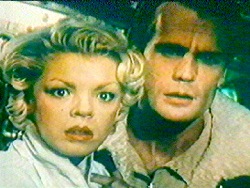Gusztáv Hámos
Biography
Berlin-based artist Gusztáv Hámos, who emigrated from Hungary in 1979, explores the nexus of media and reality in his film and video works. Exploring the significance of myths and heroes in popular culture, Hámos constructs ironic, idiosyncratic fictions that quote sources from classical Greece to Hollywood, Snow White to comic book superheroes, science fiction to film noir thrillers.
Hámos' highly stylized pastiches integrate mass media appropriations and tongue-in-cheek references to the genres and archetypes of popular narratives. Artful and witty, these multi-textual works reflect an eclectic "international style" informed by Hámos' participation in Berlin's Super-8 film movement, his Eastern European heritage, and his fascination with the emblematic meaning of Hollywood cinema, television, advertising, and pop-cultural representations. Often collaborating with a core of Berlin-based film and videomakers — including Astrid Heibach, Ed Cantu, Marian Kiss and Christoph Dreher — Hámos typically juxtaposes small-format video with 16 mm film and images appropriated from cinema and television. With protagonists that range from vampires to Socrates, Hámos' wry fictions illustrate — through an analysis of the fabrication of image and reality, fantasy and truth — the omnipotence of cultural heroes, icons and mythologies.
More recently, he has expanded this inquiry to the relation of mass media, political myths, and personal narrative. In "1989" The Real Power of TV, Hámos juxtaposes the political turmoil of 1989 — as seen on television news — with the day-to-day reality of his elderly grandmother in Hungary.
Gusztáv Hámos was born in 1955 in Budapest, Hungary. He studied at the Filmstudio Bela Balazs, Budapest. After his emigration in 1979 he studied at the Deutschen Film und Fernsehakademie in what was then West Berlin. With Astrid Heibach and Vera and Gabor Body, Hámos was instrumental in establishing Infermental, the first international video magazine, in Berlin. In 1984, he was awarded the Marl Special Award for Video, and was artist-in-residence at P.S. 1 in New York in 1988. He has produced numerous film and video works for European television. His videotapes have been exhibited internationally, at institutions and festivals including The Museum of Modern Art, New York; Neuer Berliner Kunstverein, Berlin; Documenta 8, Kassel, Germany; Stedelijk Museum, Amsterdam; The Institute of Contemporary Art, Boston; Badischer Kunstverein, Karlsruhe, Germany; Centre Georges Pompidou, Paris; Centro de Arte Reina Sofia, Madrid; the San Francisco Museum of Modern Art; the Ludwig Museum, Budapest, Hungary; the Montreal Film Festival; the World Wide Video Festival, Amsterdam; the Cannes film festival, the Festival Internacional de Cine San Sebastian Spain, the Ludwig Forum für Internationale Kunst Aachen, the Kunsthaus Dresden Städtische Galerie für Gegenwartskunst, and the Edith-Ruß-Haus für Medienkunst. Hámos lives in Berlin.
